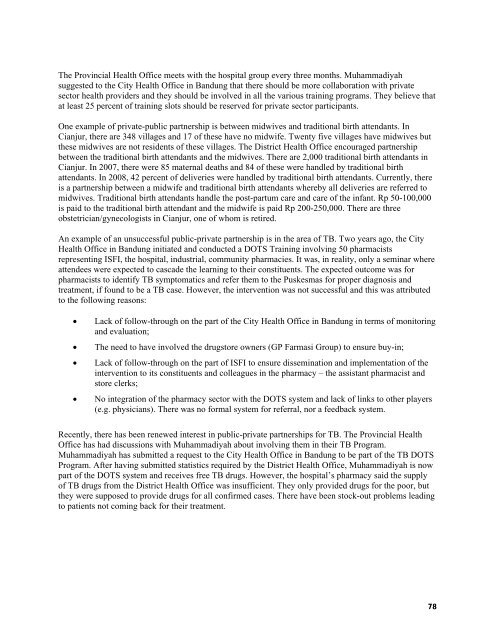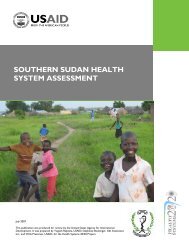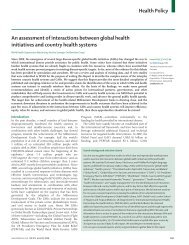The Provincial <strong>Health</strong> Office meets with the hospital group every three months. Muhammadiyahsuggested to the City <strong>Health</strong> Office in Bandung that there should be more collaboration with privatesector health providers and they should be involved in all the various training programs. They believe thatat least 25 percent of training slots should be reserved for private sector participants.One example of private-public partnership is between midwives and traditional birth attendants. InCianjur, there are 348 villages and 17 of these have no midwife. Twenty five villages have midwives butthese midwives are not residents of these villages. The District <strong>Health</strong> Office encouraged partnershipbetween the traditional birth attendants and the midwives. There are 2,000 traditional birth attendants inCianjur. In 2007, there were 85 maternal deaths and 84 of these were handled by traditional birthattendants. In 2008, 42 percent of deliveries were handled by traditional birth attendants. Currently, thereis a partnership between a midwife and traditional birth attendants whereby all deliveries are referred tomidwives. Traditional birth attendants handle the post-partum care and care of the infant. Rp 50-100,000is paid to the traditional birth attendant and the midwife is paid Rp 200-250,000. There are threeobstetrician/gynecologists in Cianjur, one of whom is retired.An example of an unsuccessful public-private partnership is in the area of TB. Two years ago, the City<strong>Health</strong> Office in Bandung initiated and conducted a DOTS Training involving 50 pharmacistsrepresenting ISFI, the hospital, industrial, community pharmacies. It was, in reality, only a seminar whereattendees were expected to cascade the learning to their constituents. The expected outcome was forpharmacists to identify TB symptomatics and refer them to the Puskesmas for proper diagnosis andtreatment, if found to be a TB case. However, the intervention was not successful and this was attributedto the following reasons:• Lack of follow-through on the part of the City <strong>Health</strong> Office in Bandung in terms of monitoringand evaluation;• The need to have involved the drugstore owners (GP Farmasi Group) to ensure buy-in;• Lack of follow-through on the part of ISFI to ensure dissemination and implementation of theintervention to its constituents and colleagues in the pharmacy – the assistant pharmacist andstore clerks;• No integration of the pharmacy sector with the DOTS system and lack of links to other players(e.g. physicians). There was no formal system for referral, nor a feedback system.Recently, there has been renewed interest in public-private partnerships for TB. The Provincial <strong>Health</strong>Office has had discussions with Muhammadiyah about involving them in their TB Program.Muhammadiyah has submitted a request to the City <strong>Health</strong> Office in Bandung to be part of the TB DOTSProgram. After having submitted statistics required by the District <strong>Health</strong> Office, Muhammadiyah is nowpart of the DOTS system and receives free TB drugs. However, the hospital’s pharmacy said the supplyof TB drugs from the District <strong>Health</strong> Office was insufficient. They only provided drugs for the poor, butthey were supposed to provide drugs for all confirmed cases. There have been stock-out problems leadingto patients not coming back for their treatment.78
What can be done to rationalize the use of medications as part of anintegrated provider quality improvement approach?2.5 Sources of Medications for Private ProvidersIn Indonesia, there are 204 pharmaceutical manufacturers, 49 sole/first layer distributors, 2,560 secondlayer distributors or Perusaahaan Besar Farmasi (PBF) responsible for distributing drugs to hospitals,pharmacies, and drug stores. The sole distributors manage distribution of one manufacturer to variousPBF. In Indonesia, there are 5,695 pharmacies (which must have a pharmacist and are the only approvedvenue outside of a hospital or clinic to sell prescription drugs) and 5,513 drug stores (which sell over-thecountermedications and have an assistant pharmacist).Hospitals and stand-alone pharmacies purchased their medications locally from these distributors.Individual midwives would purchase drugs either from a local pharmacy or through pharmaceuticalrepresentatives. IBI has initiated a move similar to Yogyakarta where the IBI uses its resources to buymedications at a discounted price and sell them to its members. This system works reasonably well.However, the drugs are only distributed at IBI meetings, and these meetings are not held often enough.Midwives do not have spare money to hold stocks. Therefore, midwives, particularly those in rural areas,often have to buy drugs from the private market when they need them.There was wide variation in how the different hospitals procured medications. The Borromeus Group, aCatholic group of hospitals and clinics, does group-purchasing for specific drugs. Most of the time, eachmember group procures its own drugs and supplies from PERDHAKI. The Borromeus Group, along withother Catholic health facilities, is a member of PERDHAKI, and as a member they get to procure their drugsand supplies from PERDHAKI at relatively reduced cost. Delivery of these drugs and supplies by thesupplier are free of charge regardless of destination within the country. PERDHAKI conducts an annualmembership meeting for synergy. It also provides training opportunities for its members (e.g. financialmanagement) for free. There are scheduled trainings during the year.Adventist Hospital in Bandung is a part of the Adventist group which has various health care facilitiesincluding 60 clinics nationwide. The various hospitals within the Adventist group are each separateFoundations, and each facility is autonomous. There is no pooling of resources for joint procurement ofdrugs and supplies. The idea of a central framework procurement for the whole group has never beendiscussed.Muhammadiyah Hospital, which despite being part of a large network of providers, also procures itsdrugs and supplies only for itself. There is no joint supply chain for the network.In general, procurement of drugs by private providers is currently not a problem. Drugs are readilyavailable from various sources.2.6 Potential Role of District as supply point for private providersCurrently, vaccines, the drug regimen for tuberculosis and some malaria drugs, which are part of verticalprograms from the Ministry of <strong>Health</strong>, are received by qualified private providers from the District <strong>Health</strong>Office in Bandung. These drugs are intended to be passed on to the consumer at no cost to the patient.There is a problem specifically with TB drugs. The head of the Provincial <strong>Health</strong> Office reported that TBdrugs coming from the Central <strong>Health</strong> Department had been delayed by two months, and that interruptedsupply has been common. Currently, there is no problem with TB drugs. The budget for TB drugs comes79
- Page 1:
PRIVATE SECTOR HEALTHCARE IN INDONE
- Page 5:
PRIVATE SECTOR HEALTH CAREIN INDONE
- Page 8 and 9:
7. Rationalizing Use of Medications
- Page 11 and 12:
ABBREVIATIONSANCAskesAskeskinAusAID
- Page 13:
THEUSAIDVATWHOTotal health expendit
- Page 17 and 18:
EXECUTIVE SUMMARYAs documented in I
- Page 19 and 20:
By using their power to select whic
- Page 21:
higher reimbursement for complex de
- Page 25 and 26:
2. BACKGROUND2.1 GENERAL BACKGROUND
- Page 27 and 28:
While decentralization of the healt
- Page 29:
FIGURE 1: TOTAL EXPENDITURES ON HEA
- Page 32 and 33:
poor, which only allows use of publ
- Page 34 and 35:
Lack of overall investment in healt
- Page 36 and 37:
• Pharmacists and drugsellers - A
- Page 38 and 39:
4.2 ASSESSMENT APPROACHData collect
- Page 40 and 41:
practice, however, limited resource
- Page 42 and 43:
Dinas to the hospital detailing the
- Page 44 and 45:
Unlike Muhammadiyah and NU faciliti
- Page 46 and 47:
TABLE 3: POPULATION COVERAGE BY HEA
- Page 48 and 49:
customary fees. At the same time, i
- Page 51 and 52: 7. RATIONALIZING USE OFMEDICATIONS7
- Page 53 and 54: too few medicines to meet the publi
- Page 55 and 56: 8. PHARMACISTS ANDDRUGSELLERS AS PA
- Page 57 and 58: district provides TB drugs to priva
- Page 59 and 60: 9. ROLE OF PROFESSIONALASSOCIATIONS
- Page 61 and 62: IMA is involved in any allegations
- Page 63 and 64: 10. CONCLUSIONS ANDRECOMMENDATIONSI
- Page 65: If Indonesia is to achieve its prio
- Page 68 and 69: • Supporting the mapping of all f
- Page 71 and 72: ANNEX A: ASSESSMENT GUIDEIndonesia
- Page 73 and 74: Key Informants at Provincial LevelK
- Page 75: Key InformantsoooIBI, and memberrep
- Page 78 and 79: Assessment Question Approach/Backgr
- Page 80 and 81: Indicator Number Data Source and No
- Page 82 and 83: 1.3.4 DinKes Experience with Privat
- Page 84 and 85: The team interviewed a manager 16 a
- Page 86 and 87: They have used many different healt
- Page 88 and 89: In Yogyakarta Province, there are 1
- Page 90 and 91: graduates to work immediately in 24
- Page 92 and 93: Muhammadiyah is a 226 bed hospital
- Page 94 and 95: Dinas Yogyakarta31. Mardiningsih, S
- Page 96 and 97: 2.1 Provincial InformationThe popul
- Page 98 and 99: How can services provided at privat
- Page 102 and 103: from multiple sources: 40 percent f
- Page 104 and 105: 2.9 Licensing and Oversight of Phar
- Page 106 and 107: As per IMA Propinsi, they meet with
- Page 108 and 109: It was mentioned that the budget fo
- Page 110 and 111: • Private midwives are willing to
- Page 112 and 113: etween PKBI and the District Health
- Page 114 and 115: Cahya Kawaluyan Hospital has adapte
- Page 116 and 117: the midwife to charge a slightly hi
- Page 118 and 119: Involving Physicians in DOTS. A sig
- Page 120 and 121: Ikatan Bidan Indonesia (IBI) West J
- Page 122 and 123: Indicator DKI West Jakarta Data Sou
- Page 124 and 125: visited an average of over 60 perce
- Page 126 and 127: 3.9 Potential role of professional
- Page 128 and 129: members who pay membership fees. Th
- Page 130 and 131: emainder paying out of pocket. Reve
- Page 132 and 133: 3.20 Indonesian Pharmacists Associa
- Page 134 and 135: OtherApotek Gitamara, Jl. Kemanggis
- Page 136 and 137: 13. Government of Indonesia, World
- Page 138: 41. Thrabany, Hasbullah, et al. 200
















